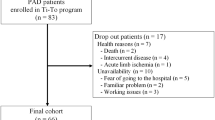Summary
The treadmill walking test, although it remains the reference method for evaluating patients with peripheral arterial occlusive disease, does not measure the functional discomfort experienced by patients under normal physiological walking conditions. A novel device (Peripheral Arterial Disease Holter Control; PADHOC®) that has been developed makes it possible to measure the various components of a patient’s gait in an outpatient setting (walking speed, walking distance to onset of pain, maximum walking distance). The measuring principle is based on analysis of the time taken for an ultrasound wave to travel between two sensors fixed to the inside of each of the patient’s ankles. The device has been validated in a multicentre trial [the Double Epreuve de Marche PHYsiologique (DEMPHY) study]. All patients performed both a Strandness and 2 physiological walking tests on the same day. 206 patients were included. The study demonstrated that PADHOC® was a more appropriate tool than the Strandness test for evaluating incapacity caused by arterial disease and in quantifying the severity of the lesions observed. It was also significantly more acceptable to patients (p < 0.001).
Similar content being viewed by others
References
CPMP Working Party. Clinical investigations of medicinal products in the treatment of chronic peripheral arterial disease, Note for Guidance, EMEA Status as of November 1995
Hiatt WR, Wolfel EE, Meier RH, et al. Superiority of treadmill walking exercise versus strength training for patients with peripheral arterial disease. Implications for the mechanism of the training response. Circulation 1994; 90(4): 1866–74
Barthelemy L, Sebert P, Mialon P. Contribution to the study of the physiological significance of the Ruffier test. Med Sport 1987; 61(4): 171–3
Heidrich H, Allenberg J, Cachovan M, et al. Guidelines for therapeutic studies on peripheral arterial occlusive disease in Fontaine states II-IV. Vasa1992; 21(4): 339–43
Strandness DE. Exercise testing in the evaluation of patients undergoing direct arterial surgery. J Cardiovasc Surg 1970; 11: 192–200
Gardner AW, Ricci MA, Case TD, et al. Practical equations to predict claudication pain distances from a graded treadmill test. Vasc Med 1996; 1: 91–6
Regensteiner JG, Meyer TJ, Krupski WC, et al. Hospital vs home-based exercise rehabilitation for patients with peripheral arterial occlusive disease. Angiology 1997; 48(4): 291–9
Bouchet JY, Franco A, Morzol B, et al. Evaluation objective de la claudication intermittente arteriélle par l’épreuve de marche. Etude comparative de la marche physiologique et sur tapis roulant. J Mal Vasc 1980; 5: 177–9
Perrot G, Barth P, Gamand S, et al. Peripheral Arterial Disease Holter Control (PADHOC®): une alternative au tapis roulant. Principes et conception. Médecine vasculaire: angiologie et explorations fonctionnelles vasculaires. Boissier C, Carpentier PH, Mollard JM, editors. Paris: John Libbey Eurotext, 1995: 113–4
Boissier C, Benichou AC, Bachongy P, et al. Peripheral Arterial Disease Holter Control (PADHOC®): une alternative au tapis roulant. Méthodologie et utilisation clinique. Médecine vasculaire: angiologie et explorations fonctionnelles vasculaires. Boissier C, Carpentier PH, Mollard JM, editors. Paris: John Libbey Eurotext, 1995: 96–7
Author information
Authors and Affiliations
Rights and permissions
About this article
Cite this article
Boissier, C., Benichou, A.C., Gamand, S. et al. A New Device for the Diagnosis and Investigation of Patients with Peripheral Arterial Occlusive Disease. Dis-Manage-Health-Outcomes 2 (Suppl 1), 57–64 (1997). https://doi.org/10.2165/00115677-199700021-00012
Published:
Issue Date:
DOI: https://doi.org/10.2165/00115677-199700021-00012



